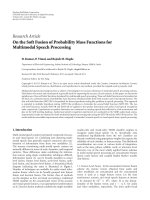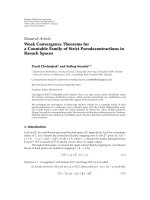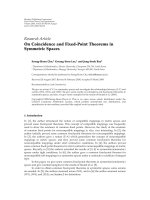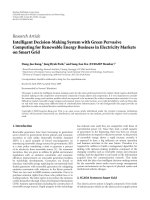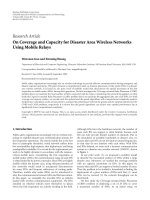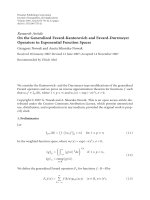Báo cáo hóa học: " Research Article On Subordination Result Associated with Certain Subclass of Analytic Functions Involving Salagean Operator" doc
Bạn đang xem bản rút gọn của tài liệu. Xem và tải ngay bản đầy đủ của tài liệu tại đây (465.89 KB, 6 trang )
Hindawi Publishing Corporation
Journal of Inequalities and Applications
Volume 2007, Article ID 48294, 6 pages
doi:10.1155/2007/48294
Research Article
On Subordination Result Associated with Certain Subclass of
Analytic Functions Involving Salagean Operator
Sevtap S
¨
umer Eker, Bilal S¸eker, and Shigeyoshi Owa
Received 3 February 2007; Accepted 15 May 2007
Recommended by Narendra K. Govil
We obtain an interesting subordination relation for Salagean-type certain analytic func-
tions by using subordination theorem.
Copyright © 2007 Sevtap S
¨
umer Eker et al. This is an open access article distributed un-
der the Creative Commons Attribution License, which permits unrestricted use, distri-
bution, and reproduction in any medium, provided the original work is properly cited.
1. Introduction
Let Ꮽ denote the class of functions f (z) normalized by
f (z)
= z +
∞
j=2
a
j
z
j
, (1.1)
which are analytic in the open unit disk
U
={
z ∈ C : |z| < 1}. We denote by
∗
(α)and
(α)(0
≤ α<1) the class of starlike functions of order α and the class of convex functions
of order α, respectively, where
∗
(α) =
f ∈ Ꮽ :Re
zf
(z)
f (z)
>α, z ∈ U
,
(α)
=
f ∈ Ꮽ :Re
1+
zf
(z)
f
(z)
>α, z ∈ U
.
(1.2)
Note that f (z)
∈ (α) ⇔ zf
(z) ∈
∗
(α).
2 Journal of Inequalities and Applications
S
˘
al
˘
agean [1] has introduced the following operator:
D
0
f (z) = f (z),
D
1
f (z) = Df(z) = zf
(z),
.
.
.
D
n
f (z) = D
D
n−1
f (z)
, n ∈ N
0
={0}∪{1,2, }.
(1.3)
We note that
D
n
f (z) = z +
∞
j=2
j
n
a
j
z
j
n ∈ N
0
=
N ∪{
0}
. (1.4)
We denote by S
n
(α) subclass of the class Ꮽ which is defined as follows:
S
n
(α) =
f : f ∈ Ꮽ,Re
D
n+1
f (z)
D
n
f (z)
>αz∈ U;0<α≤ 1
. (1.5)
The class S
n
(α) was introduced by Kadio
ˇ
glu [2]. We begin by recalling following coef-
ficient inequality associated with the function class S
n
(α).
Theorem 1.1 (Kadio
ˇ
glu [2]). If f (z)
∈ Ꮽ,definedby(1.1), satisfies the coefficient inequal-
ity
∞
j=2
j
n+1
− αj
n
a
j
≤
1 − α,0≤ α<1, (1.6)
then f (z)
∈ S
n
(α).
In view of Theorem 1.1, we now introduce the subclass
S
n
(α) ⊂ S
n
(α), (1.7)
which consists of functions f (z)
∈ Ꮽ whose Taylor-Maclaurin coefficients satisfy the in-
equality (1.6).
In this paper, we prove an interesting subordination result for the class
S
n
(α). In our
proposed investigation of functions in the class
S
n
(α), we need the following definitions
and results.
Definit ion 1.2 (Hadamard product or convolution). Given two functions f ,g
∈ Ꮽ where
f (z)isgivenby(1.1)andg(z)isdefinedby
g(z)
= z +
∞
j=2
b
j
z
j
. (1.8)
Sevtap S
¨
umer Eker et al. 3
The Hadamard product (or convolution) f
∗ g is defined (as usual) by
( f
∗ g)(z) = z +
∞
j=2
a
j
b
j
z
j
= (g ∗ f )(z), z ∈ U. (1.9)
Definit ion 1.3 (subordination principle). For two functions f and g analytic in
U,the
function f (z)issubordinatetog(z)in
U
f (z) ≺ g(z), z ∈ U, (1.10)
if there exists a Schwarz function w(z), analytic in
U with
w(0)
= 0,
w(z)
< 1, (1.11)
such that
f (z)
= g
w(z)
, z ∈ U. (1.12)
In particular, if the function g is univalent in
U, the above subordination is equivalent to
f (0)
= g(0), f (U) ⊂ g(U). (1.13)
Definit ion 1.4 (subordinating factor sequence). A sequence
{b
j
}
∞
j=1
of complex numbers
is said to be a subordinating factor sequence if whenever f (z)oftheform(1.1)isanalytic,
univalent, and convex in
U, the subordination is given by
∞
j=1
a
j
b
j
z
j
≺ f (z); z ∈ U, a
1
= 1. (1.14)
Theorem 1.5 (Wilf [3]). The sequence
{b
j
}
∞
j=1
is subordinating factor sequence if and only
if
Re
1+2
∞
j=1
b
j
z
j
> 0 z ∈ U. (1.15)
2. Main theorem
Theorem 2.1. Let the function f (z) defined by (1.1) be in the class
S
n
(α). Also, let denote
familiar class of functions f (z)
∈ Ꮽ which are univalent and convex in U. Then
2
n
− α2
n−1
(1 − α)+
2
n+1
− α2
n
( f ∗ g)(z) ≺ g(z)
z ∈ U; n ∈ N
0
; g(z) ∈
, (2.1)
Re f (z) >
−
(1 − α)+
2
n+1
− α2
n
2
n+1
− α2
n
. (2.2)
4 Journal of Inequalities and Applications
The following constant factor in the subordination result (2.1):
2
n
− α2
n−1
(1 − α)+
2
n+1
− α2
n
(2.3)
cannot be replaced by a larger one.
Proof. Let f (z)
∈
S
n
(α) and suppose that
g(z)
= z +
∞
j=2
c
j
z
j
∈ . (2.4)
Then
2
n
− α2
n−1
(1 − α)+
2
n+1
− α2
n
( f ∗ g)(z) =
2
n
− α2
n−1
(1 − α)+
2
n+1
− α2
n
z +
∞
j=2
a
j
c
j
z
j
. (2.5)
Thus, by Definition 1.4, the subordination result (2.1)willholdtrueif
2
n
− α2
n−1
(1 − α)+
2
n+1
− α2
n
a
j
∞
j=1
(2.6)
is a subordinating factor sequences, with a
1
= 1. In view of Theorem 1.5, this is equivalent
to the following inequality:
Re
1+2
∞
j=1
2
n
− α2
n−1
(1 − α)+
2
n+1
− α2
n
a
j
z
j
> 0 z ∈ U. (2.7)
Now, since j
n+1
− j
n
(j ≥ 2, n ∈ N
0
) is an increasing function of j,wehave
Re
1+2
∞
j=1
2
n
− α2
n−1
(1 − α)+
2
n+1
− α2
n
a
j
z
j
=
Re
1+
∞
j=1
2
n+1
− α2
n
(1 − α)+
2
n+1
− α2
n
a
j
z
j
=
Re
1+
2
n+1
− α2
n
(1 − α)+
2
n+1
− α2
n
a
1
z +
1
(1 − α)+
2
n+1
− α2
n
∞
j=2
2
n+1
− α2
n
a
j
z
j
≥
1 −
2
n+1
− α2
n
(1 − α)+
2
n+1
− α2
n
r −
1
(1 − α)+
2
n+1
− α2
n
∞
j=2
j
n+1
− αj
n
a
j
r
j
> 1 −
2
n+1
− α2
n
(1 − α)+
2
n+1
− α2
n
r −
1 − α
(1 − α)+
2
n+1
− α2
n
r>0
|
z|=r<1
,
(2.8)
Sevtap S
¨
umer Eker et al. 5
wherewehavealsomadeuseoftheassertion(1.6)ofTheorem 1.1. This evidently proves
the inequality (2.7), and hence also the subordination result (2.1) asserted by our theo-
rem. The inequality (2.2)followsfrom(2.1)uponsetting
g(z)
=
z
1 − z
=
∞
j=1
z
j
∈ . (2.9)
Now, consider the function
f
0
(z) = z −
1 − α
2
n+1
− α2
n
z
2
n ∈ N
0
,0≤ α<1
, (2.10)
which is a member of the class
S
n
(α). Then by using (2.1), we have
2
n
− α2
n−1
(1 − α)+
2
n+1
− α2
n
f
0
∗ g
(z) ≺
z
1 − z
. (2.11)
It can be easily verified for the function f
0
(z)definedby(2.10)that
minRe
2
n
− α2
n−1
(1 − α)+
2
n+1
− α2
n
f
0
∗ g
(z)
=−
1
2
, z
∈ U, (2.12)
which completes the proof of theorem.
If we take n = 0inTheorem 2.1, we have the following corollary.
Corollary 2.2. Let the function f (z) defined by (1.1) be in the class
∗
(α) and g(z) ∈ ,
then
2
− α
2(3 − 2α)
( f
∗ g)(z) ≺ g(z), (2.13)
Re f (z) >
−
3 − 2α
2 − α
(z
∈ U). (2.14)
The constant factor
2
− α
2(3 − 2α)
(2.15)
in the subordination result (2.13) cannot be replaced by a large r one.
If we take n
= 1inTheorem 2.1, we have the following corollary.
6 Journal of Inequalities and Applications
Corollary 2.3. Let the function f (z) defined by (1.1) be in the class (α) and g(z)
∈ ,
then
2
− α
5 − 3α
( f
∗ g)(z) ≺ g(z), (2.16)
Re f (z) >
−
5 − 3α
2(2 − α)
(z
∈ U). (2.17)
The constant factor
2
− α
5 − 3α
(2.18)
in the subordination result (2.16) cannot be replaced by a large r one.
References
[1]G.S.S
˘
al
˘
agean, “Subclasses of univalent functions,” in Complex Analysis—Proceedings of 5th
Romanian-Finnish Seminar—Part 1 (Bucharest, 1981), vol. 1013 of Lecture Notes in Math.,pp.
362–372, Springer, Berlin, Germany, 1983.
[2] E. Kadio
ˇ
glu, “On subclass of univalent functions with negative coefficients,” Applied Mathemat-
ics and Computation, vol. 146, no. 2-3, pp. 351–358, 2003.
[3] H. S. Wilf, “Subordinating factor sequences for convex maps of the unit circle,” Proceedings of
the American Mathematical Society, vol. 12, pp. 689–693, 1961.
Sevtap S
¨
umer Eker: Department of Mathematics, Faculty of Science and Letters, Dicle University,
21280 Diyarbakir, Turkey
Email address:
Bilal S¸ eker: Department of Mathematics, Faculty of Science and Letters, Dicle University,
21280 Diyarbakir, Turkey
Email address:
Shigeyoshi Owa: Department of Mathematics, Kinki University, Higashi-Osaka,
Osaka 577-8502, Japan
Email address:
